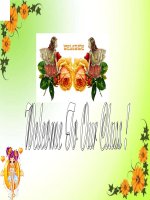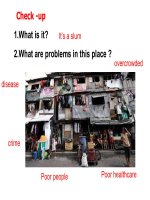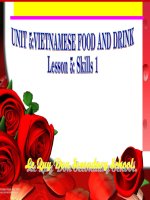Unit 07 Pollution Lesson 2 A Closer Look 1
Bạn đang xem bản rút gọn của tài liệu. Xem và tải ngay bản đầy đủ của tài liệu tại đây (104.94 KB, 5 trang )
UNIT 7: POLLUTION.
PERIOD 59: lesson 2: A CLOSERLOOK 1
I/ Objectives:
1. Educational aim: - Practice the vocabulary and pronunciation of the unit.
2. Knowledge:
- Vocabulary: words related to the topic.
- Grammatical structures:
- Pronunciation: intonation in exclamatory sentences.
3. Skills: Speaking, Listening and writing.
II/ Teaching aids:
- T: lesson plan, visual pictures
- Ss: vocabularies related to hobbies
III/ Procedures :
IV/ Procedures :
Steps and time
Learning activities
Language
Models
focus
A. Warm –
Ask Ss to call out the types of
+whole
up( 5’):
pollution they learnt in the previous
class, team
lesson. Tell them that in this lesson
work.
they are going to learn different forms
of some words as well as some
words/ phrases to talk about the
B.Vocabulary. causes and effects of pollution.
(25’)
1. Complete the table with
Individual
appropriate verbs, nouns, and Poison
adjectives.
Contaminate
Have Ss look at the table in the book. Pollution
Make sure that they understand what Polluted
to do. Ss complete the exercise Death
Whole
individually and then compare their Damaged
class
answers with a partner. Call on some
Ss to write their answers on the board.
Check their answers.
Key: 1. Poison 2.
Contaminate
3. Pollution4. Polluted 5.
Death 6. Damaged
2. Complete the sentences with the
words from the table in 1. You do
not need to use all the words. The
first letter of each word has been
provided.
Have Ss read each sentence silently to
have a general understanding and
Individual
decide which word form should be
Pair work
put in each blank. For example, the Poisonous
word to be filled in the blank in Pollutants
sentence 1 is an adjective. Point out
that the provided letter is a clue to
help them find the word. Ss do the
exercise and then compare their
answers with a partner. Call on one or
two Ss to give out the answers before
confirming the correct ones.
Key: 1. Poisonous
2. Pollutants
3. Dead 4. Contaminated
5. Damage 6. Pollute
Have Ss look at the language box.
Tell Ss that the words and phrases in
the box express cause and effect
relationships. Ss have learn so,
because of. Quickly go through the
rest of words/ phrases as follows:
- Because/ since and due to/ because
of are used to talk about the causes of
something.
Because and since are synonyms and
they come before a clause.
Due to and because of are synonyms
and they come before a noun phrase.
Have Ss read the example sentences
and underline the clause or noun
phrase.
- Other words and phrases in the box
express the effects of something.
So comes before a clause.
To cause, to lead to and to result in
are synonyms and come before a
noun phrase.To make Sb/ sth do sth is
another way to express the effects.
After somebody/ something is an
infinitive verb without to.
Have Ss read the example sentences
and underline the clause, noun phrase,
or infinitive.
For more able Ss, T may have Ss read
the sentences and explain the rules
themselves by using the words and
phrases.
3a Decide which sentence in each
pair of sentences is a cause and
which is an effect. Write C (for
cause) or F (for effect) next to each
sentence. Note that the words in
Dead
Contaminated
Damage
Pollute
The words and
phrases in the
box
express
cause
and
effect
relationships.
- so, because
of.
Because/
since and due
to/ because of
are used to talk
about
the
causes
of
something.
Because and
since
are
synonyms and
they
come
before
a
clause.
Due to and
because of are
synonyms and
they
come
before a noun
phrase.
+whole
class, team
work.
Individual
Whole
class
Whole
class
Individual
Pair work
brackets relate to Activity 3b.
Ask Ss to read the each pair of
sentences and decide which sentence
is an effect. Ss compare their answers
with a partner before giving the
answers to the teacher. Confirm the
correct answers.
b. Combine the sentences in each
pair into a new sentence that shows
a cause/ effect relationship. Use the
cause or effect signal word or
phrase given in brackets. You will
have to add, delete, or change
words in most sentences.
Ask Ss to read the example. Ask them
what changes they can see in the
sentence. T may have Ss look at the
language box again to remind them of
the structures. Now Ss have to
combine each pair of sentences in 3a
into a complete sentence using the
word/ phrase in brackets. To save
time assign sentences 2 to 5 to
different Ss and have Ss word only
these. Call on some Ss to write their
sentences on the board and correct
them carefully. T can ask Ss to write
all the sentences at homework.
2. Oil spills from ships in oceans and
rivers lead to the death of many
aquatic animals and plants.
3.Households dump waste into the
river so it is polluted.
4. Since the parents were exposed to
radiation their children have birth
defects.
5. We can’t see the stars at night
due to the light pollution.
4. Work in groups. Look at the
pairs of pictures. Give as many
sentences as possible to show cause/
effect relationships.
Have Ss look at the pictures in 1. Ask
Ss which picture shows the cause and
which shows the effect. Then ask
them to read the example sentences
and pay attention to the cause/ effect
+whole
class, team
work.
Individual
Individual
Pair work
Whole
class.
Whole
class
Individual
Pair work
C.
Pronunciation
.
(10’)
words or phrases. Ss work in pairs to
write sentences showing cause/ effect
relationships. For a more able class, T
may have Ss do the whole exercise.
With other classes, just ask Ss to
work with the pair of pictures in 2.
Ask ss to identify the picture showing
the cause and the one showing the
effect. Then together make up
sentences, using the cause/ effect
words or phrases. The rest can be
done as homework.
This activity can also ba carried out
as a game. Divide the class into 12
groups. Two groups work with the
same pair of pictures in 2, 3 or 4. In
three minutes, groups of Ss write
down as many sentences based on the
given picture pair as possible on a
sheet of paper. When time is up, the
group with the most sentences is the
winner. They stick their sheet of
paper on the board and read the
sentences aloud. Other groups and T
givens comments. Other groups can
add any sentences they have. T may
Ss’ work home to mark it.
Suggested answers:
2. The soil is polluted, so plants can’t
grow.
3. We won’t have fresh water to drink
because of water pollution.
4. We plant trees, so we can have
frest air.
Pronunciation
Stress in words ending in – ic and –
al.
Ask Ss to look at the rules in the box
and the examples. Go through the
rules with them. For a more able
class, have Ss give some more
examples.
5. Listen and mark the stress in
each word, then repeat it.
Play the recording for Ss to tress the
words. Ask some to say where the
tress in each word is. Confirm the
+whole
class, team
work.
Individual
Whole
class
1. ar’tistic
6. ’physical
2. ath’letic
7. he’roic
3. his’toric
8. po’etic
4. his’torical
9. bo’tanic
5. ’logical
10. Bo’tanical
Individual
Pair work
1. scien’tific
2. ’national
3. ’madical
4. ’chemical
5. dra’matic
+whole
class, team
work.
correct answers. Play the recording
again for Ss to repeat the words. Call
whole class
D. Home
on some Sts to pronoun.
assignment(3’) 6. Underline the words ending in –
ic and circle the words ending in –
al in the following sentences. Mark
the stress in each word. Listen and
check your answers, then repeat the
sentences.
Have Ss do the activity individually.
Play the recording for Ss to check
their answers. Then elicit the correct
stress patterns from Ss. Play the
recording again for Ss to repeat the
sentences. Ask some Ss ro read out
the sentences.
Ask students to complete all the
exercises
*Feedback:…...
…………………………………………………………………………………………
…………………………………………………………………………









